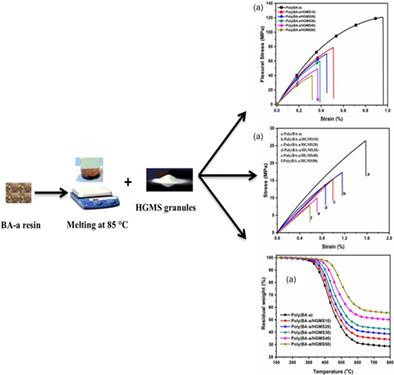当前位置:
X-MOL 学术
›
J. Appl. Polym. Sci.
›
论文详情
Our official English website, www.x-mol.net, welcomes your
feedback! (Note: you will need to create a separate account there.)
Effects of hollow glass microspheres on the polybenzoxazine thermosets: Mechanical, thermal, heat insulation, and morphological properties
Journal of Applied Polymer Science ( IF 2.7 ) Pub Date : 2021-09-14 , DOI: 10.1002/app.51643 Sadia Kiran 1 , Athar Ali Khan Gorar 1, 2 , Ting Wang 1 , Abdul Qadeer Dayo 1, 3 , Li‐Li Zhang 1 , Jun Wang 1 , Ahmer Hussain Shah 3 , Syed Kamran Sami 3 , Wen‐Bin Liu 1
Journal of Applied Polymer Science ( IF 2.7 ) Pub Date : 2021-09-14 , DOI: 10.1002/app.51643 Sadia Kiran 1 , Athar Ali Khan Gorar 1, 2 , Ting Wang 1 , Abdul Qadeer Dayo 1, 3 , Li‐Li Zhang 1 , Jun Wang 1 , Ahmer Hussain Shah 3 , Syed Kamran Sami 3 , Wen‐Bin Liu 1
Affiliation

|
The growing need for high thermal and mechanical resistant lightweight syntactic foams demands the designing of new materials. Herein, we report the successful fabrication of lightweight and high thermal resistance syntactic foams with excellent thermal and good mechanical properties. For this end, 10–50 wt% hollow glass microsphere (HGMS) containing polybenzoxazine based syntactic foams were prepared by using bisphenol-A-aniline (BA-a) and phenol-diaminodiphenylmethane (P-ddm) benzoxazine via curing at 10 MPa compression molding. The curing behavior, tensile, flexural, compressive, and impact strength, thermal properties, and fracture morphology of the syntactic foams were studied by DSC, universal material testing machine, and drop hammer impact testing machine, TGA, and SEM, respectively. The curing temperatures of BA-a and P-ddm benzoxazine resins were slightly increased after blending the HGMS. The highest decline (59%) in the density and highest void contains (13.17%) was recorded for the poly(P-ddm/HGMS50) sample. The excellent specific mechanical properties of the syntactic foams were observed on the 30 wt% HGMS loading. The thermal conductivity of the foams was gradually decreased and the lowest values of 0.106 and 0.0985 W/m.K were observed for poly(BA-a/HMGS50) and poly(P-ddm/HGMS50) sample, respectively. Furthermore, a gradual improvement in the thermal properties was observed as the loading of HGMS increased.
中文翻译:

中空玻璃微球对聚苯并恶嗪热固性塑料的影响:机械、隔热、隔热和形态特性
对高耐热性和耐机械性的轻质复合泡沫日益增长的需求要求设计新材料。在此,我们报告了具有优异热性能和良好机械性能的轻质和高耐热复合泡沫的成功制造。为此,使用双酚-A-苯胺(BA-a)和苯酚-二氨基二苯甲烷(P-ddm)苯并恶嗪通过在10 MPa压缩下固化制备了含有10-50wt%聚苯并恶嗪基复合泡沫的中空玻璃微球(HGMS)成型。通过DSC、万能材料试验机、落锤冲击试验机、TGA和SEM分别研究复合泡沫的固化行为、拉伸、弯曲、压缩和冲击强度、热性能和断裂形貌。在混合 HGMS 后,BA-a 和 P-ddm 苯并恶嗪树脂的固化温度略有增加。聚 (P-ddm/HGMS50) 样品的密度下降幅度最大 (59%),空隙含量最高 (13.17%)。在 30 wt% 的 HGMS 负载下观察到复合泡沫的优异比机械性能。泡沫的热导率逐渐降低,聚(BA-a/HMGS50)和聚(P-ddm/HGMS50)样品的最低值分别为 0.106 和 0.0985 W/mK。此外,随着 HGMS 负载的增加,观察到热性能逐渐改善。在 30 wt% 的 HGMS 负载下观察到复合泡沫的优异比机械性能。泡沫的热导率逐渐降低,聚(BA-a/HMGS50)和聚(P-ddm/HGMS50)样品的最低值分别为 0.106 和 0.0985 W/mK。此外,随着 HGMS 负载的增加,观察到热性能逐渐改善。在 30 wt% 的 HGMS 负载下观察到复合泡沫的优异比机械性能。泡沫的热导率逐渐降低,聚(BA-a/HMGS50)和聚(P-ddm/HGMS50)样品的最低值分别为 0.106 和 0.0985 W/mK。此外,随着 HGMS 负载的增加,观察到热性能逐渐改善。
更新日期:2021-11-08
中文翻译:

中空玻璃微球对聚苯并恶嗪热固性塑料的影响:机械、隔热、隔热和形态特性
对高耐热性和耐机械性的轻质复合泡沫日益增长的需求要求设计新材料。在此,我们报告了具有优异热性能和良好机械性能的轻质和高耐热复合泡沫的成功制造。为此,使用双酚-A-苯胺(BA-a)和苯酚-二氨基二苯甲烷(P-ddm)苯并恶嗪通过在10 MPa压缩下固化制备了含有10-50wt%聚苯并恶嗪基复合泡沫的中空玻璃微球(HGMS)成型。通过DSC、万能材料试验机、落锤冲击试验机、TGA和SEM分别研究复合泡沫的固化行为、拉伸、弯曲、压缩和冲击强度、热性能和断裂形貌。在混合 HGMS 后,BA-a 和 P-ddm 苯并恶嗪树脂的固化温度略有增加。聚 (P-ddm/HGMS50) 样品的密度下降幅度最大 (59%),空隙含量最高 (13.17%)。在 30 wt% 的 HGMS 负载下观察到复合泡沫的优异比机械性能。泡沫的热导率逐渐降低,聚(BA-a/HMGS50)和聚(P-ddm/HGMS50)样品的最低值分别为 0.106 和 0.0985 W/mK。此外,随着 HGMS 负载的增加,观察到热性能逐渐改善。在 30 wt% 的 HGMS 负载下观察到复合泡沫的优异比机械性能。泡沫的热导率逐渐降低,聚(BA-a/HMGS50)和聚(P-ddm/HGMS50)样品的最低值分别为 0.106 和 0.0985 W/mK。此外,随着 HGMS 负载的增加,观察到热性能逐渐改善。在 30 wt% 的 HGMS 负载下观察到复合泡沫的优异比机械性能。泡沫的热导率逐渐降低,聚(BA-a/HMGS50)和聚(P-ddm/HGMS50)样品的最低值分别为 0.106 和 0.0985 W/mK。此外,随着 HGMS 负载的增加,观察到热性能逐渐改善。











































 京公网安备 11010802027423号
京公网安备 11010802027423号